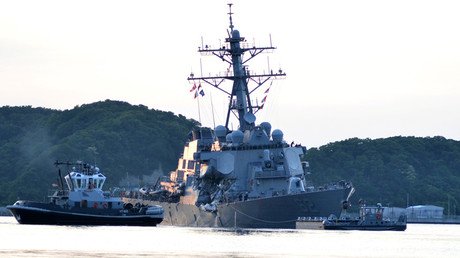US Navy commander relieved of duty after 7 sailors killed

The captain of the guided missile destroyer USS Fitzgerald has been temporarily relieved of command after seven sailors were killed when the destroyer collided with a cargo ship in Japanese waters last month, according to the US Navy.
Commander Bryce Benson was temporarily relieved for medical reasons on Tuesday, the Navy said, according to Reuters.
Benson was among those injured in the collision. He was “asleep when the accident happened and his cabin was destroyed by the impact.” He was described as “lucky to be alive.”
The Wisconsin native was med-evacuated along with two other crewmembers at the time of the incident.
Benson was appointed executive officer of the Fitzgerald in 2015, took over as commander in May.
Our #BigPicture today's from Japan: 7 flags to honor 7 sailors killed in the USS Fitzgerald collision. (📸: MC2 Raymond Diaz III / @USNavy) pic.twitter.com/KS7H31arov
— Hallie Jackson (@HallieJackson) June 27, 2017
The multiple investigations into the collision and the deaths of the sailors did not factor in Benson's relief of command, a US Navy spokesman for the 7th Fleet told USNI News.
The Fitzgerald, carrying nearly 300 crewmembers, and Philippine container ship ACX Crystal collided in the waters off Yokosuka in the predawn hours on June 17, 56 miles (90km) off the coast of Japan.
USS Fitzgerald moves into dry dock at Yokosuka for full damage assessment https://t.co/kBUKmd4jlMpic.twitter.com/OgHxYx3FAB
— Stars and Stripes (@starsandstripes) July 11, 2017
The collision caused severe damage to the starboard side of the destroyer and flooded the berths of 116 sailors below deck. Navy divers found the bodies of seven sailors who drowned inside their compartment after the Fitzgerald returned to Yokosuka.
It is unclear how fast the destroyer was going when it collided with the merchant ship. The area is particularly busy with sea traffic, said Yutaka Saito of the Japanese Coast Guard.
7 sailors died aboard the USS Fitzgerald. Here are their stories. https://t.co/HGisC7SSOC
— Sara Diaz (@lou521) July 6, 2017
The cause of the collision has not yet been released, however, Japan’s public broadcaster NHK reported the ACX Crystal, a 29,000-ton cargo vessel, had made a sharp turn shortly before the collision. The company argues the collision occurred earlier than the Navy claims, which would mean the ship turned after the collision, not before it, and may have been operating on autopilot.
The deadly incident has resulted in six investigations. Among those are two internal hearings by the US Navy, and a probe by the US Coast Guard on behalf of the National Transportation Safety Board.
Navy Struggles With Approach to Fix Crippled USS Fitzgerald | @DavidLarter@defense_newshttps://t.co/2bsZi9tcSJpic.twitter.com/0cPlhRilzW
— RealClearDefense (@RCDefense) July 1, 2017
The Japan Transport Safety Board, the Japanese Coast Guard and the Philippines government are also conducting investigations.
The probes will hear witness testimony and examine electronic data to determine exactly what took place. They will also examine the amount of time it took for the cargo ship to report the collision, with previous reports stating that the ACX Crystal took nearly an hour to call it in.
The destroyer is dry docked in Yokosuka and has a 12 foot by 17 foot hole in its starboard side below the waterline. During the collision the superstructure was crushed, three major compartments were flooded, and the impact twisted the hull of the ship and destroyed tens of millions of dollars of electrical equipment, said the Navy.
Before the ship could be dry docked, divers had to weld a complex web of patches to secure the hull enough to make the trip.
The destroyer was set to undergo a planned mid-life modernization in Fiscal Year 2019 that would have upgraded the hull, mechanical and electrical systems, according to USNI News.
At a memorial in Japan on June 27 for the seven sailors in Japan, Admiral Scott Swift surveyed the $1.5 billion destroyer’s damage.
“It’s stunning, absolutely stunning, while we mourn the loss of seven sailors, that more were not lost,” Swift, commander of the US Pacific Fleet, told reporters, according to AP.
He praised the crew for saving the ship from sinking.
“There was no understanding of what happened at the moment of impact… but there was complete understanding of what needed to be done.”
It was the greatest loss of life on a Navy vessel since the ‘USS Cole’ was bombed by Islamist militants in Yemen’s Aden Harbor in 2000.













